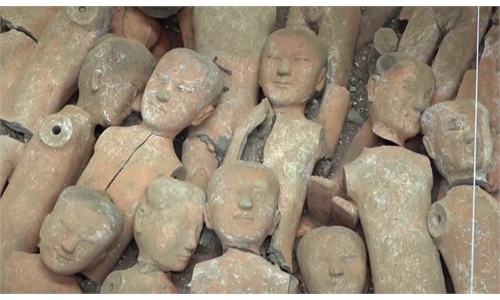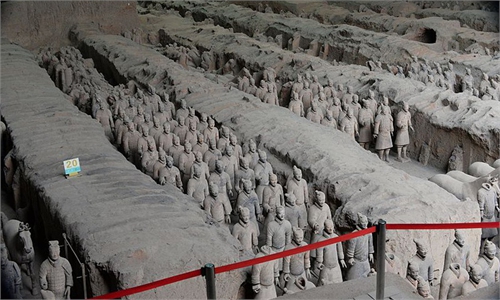ARTS / CULTURE & LEISURE
25 new pottery figurines unearthed at Emperor Qinshihuang’s mausoleum significant for researches: archaeologists

Mausoleum of the First Qin Emperor (1987)
On the foothills of Lishan Mountain, 35 kilometers northeast of Xi'an, capital of Northwest China's Shaanxi Province, the famed terra cotta army is seated. The terra cotta warriors are unique and incomparable burial objects for China's first feudal Emperor Qinshihuang, the founder of China's first collective sovereign Qin Dynasty. The mausoleum was found in 1974 and inscribed on the World Cultural Heritage list in 1987.
Among the unearthed relics, one figurine is of a general and another one of a medium-ranking officer. The 25 painted pottery figurines are in good condition, and are being stored in the protection and restoration room to ensure their safety, according to the museum's official website on late this week,.
Based on the unearthed medium- and high-ranking officer figurines previously unearthed from Pit No.1, archaeologists propose that the military arrays of the pit have a north-south and east-west symmetry. This discovery is of great significance for understanding and studying the military arrays of the entire pit.
Located in Northwest China's Shaanxi Province, the museum covers the burial site of Qin Shi Huang, or the First Emperor of the Qin Dynasty(221BC-206BC) and also China's first emperor, is famous for the Terracotta Warriors, which have earned a title as a "Wonder of the World."
Chinese archaeologists have also conducted excavation on some large buried subordinate tombs at the site as well as the restoration of unearthed relics, according to the museum.
At present, the archaeologists have restored artifacts from these tombs, including gold and silver camel sculptures, golden figurines with dancing sleeves, a copper flat pot inlaid with glaze and a small bronze figurine with a solemn face wearing a crown.
The museum has carried out excavations on these tombs since 2013. Archaeologists said that the owner of the tomb had a high status. A large number of newly unearthed precious cultural relics include three chariots and horses, a group of 15 bells and multiple gold-, silver- and bronze-made figurines, which all demonstrate the luxurious life of nobles during the Qin Dynasty.
Global Times



